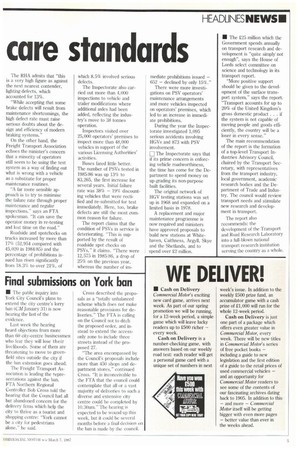Inspectors slam care standards
Page 6

Page 7

If you've noticed an error in this article please click here to report it so we can fix it.
• Increasing pressure on the haulage industry to cut costs is contributing to the high annual test failure rates for lorries, says the first-ever annual report from the Department of Transport's Vehicle Inspectorate.
The report points to an ever-increasing deterioration of the national fleet, and says that the initial failure rate — up to 22.9% from 22.0% in 1984/85 — is also due to the increased complexity of 'vehicles and longer periods between maintenance and safety inspections".
hi 1985/86 over 924,000 tests (first tests, annual tests and re-tests) were carried out on HGVs — an increase of 3% over the previous year. With over 20% of lorries and buses failing the roadworthiness test, Roads and Traffic Minister Peter Bottomley, says: "These failure rate figures are a matter for real concern and point to a need for greatly im proved maintenance."
The Department of Transport is now looking at ways of improving operators' standards of inspection and maintenance.
"We have got to consult with the industry," says a Department of Transport spokesman, "and find ways of persuading people to carry out more maintenance. With ministerial involvement and the financial resources to conduct a campaign we are sure we can persuade people to keep their vehicles in better condition."
The Road Haulage Association agrees that the initial test failure rates give cause for concern — but does not consider that it is largely because of lower maintenance standards. Brake-related defects accounted for 51% of all vehicle defects in 1985/86. The RHA admits that "this is a very high figure as against the next nearest contender, lighting defects, which accounted for 13%.
"While accepting that some brake defects will result from maintenance shortcomings, the high defect rate must raise serious doubts about the design and efficiency of modern braking systems."
On the other hand, the Freight Transport Association echoes the minister's concern that a minority of operators still seem to be using the test system as a way of finding out what is wrong with a vehicle as a substitute for proper maintenance routines.
"A far more sensible approach is to try to minimise the failure rate through proper maintenance and regular inspections," says an FTA spokesman. "It can save the operator money in re-testing and lost time on the road."
Roadside and spotchecks on trucks increased by more than 17% (52,954 compared with 45,020 in 1984/85) and the percentage of prohibitions issued has risen significantly from 18.3% to over 21%, of which 8.5% involved serious defects.
The Inspectorate also carried out more than 4,000 inspections to vehicle and trailer modifications where additional axles had been added, reflecting the industry's move to 38 tonnes operation.
Inspectors visited over 25,000 operators' premises to inspect more than 48,000 vehicles in support of the various Licensing Authorities' activities.
Buses fared little better. The number of PSVs tested in 1985/86 was up 13% to 83,265, the first increase for several years. Initial failure rate was 38% — 19% discounting vehicles that were rectified and re-submitted for test immediately. Here, too, brake defects are still the most common reason for failure.
The report claims that the condition of PSVs in service is deteriorating. "This is supported by the result of roadside spot checks on PSVs," it claims. "There were 12,575 in 1985/86, a drop of 25% on the previous year, whereas the number of im mediate prohibitions issued — 652 — declined by only 15'7, ."
There were more investigations on PSV operators' maintenance arrangements and more vehicles inspected on operators' premises, which led to an increase in immediate prohibitions.
During the year the Inspectorate investigated 1,095 serious accidents involving HOVs and 873 with PSV involvement.
1:1The Inspectorate says that if its prime concern is enforcing vehicle roadworthiness, the time has come for the Department to spend money on up-grading its non-purpose built facilities.
The original network of HGV testing stations was set up in 1968 and expanded on a limited basis in 1978.
A replacement and major maintenance programme is now required and ministers have approved proposals to build new stations at Whitehaven, Caithness, Argyll, Skye and the Shetlands, and to spend over £2 million.












































































































